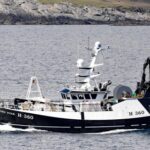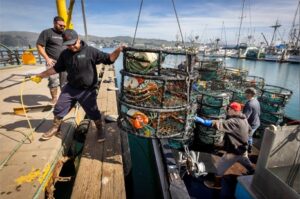More Menhaden-Scientists have found new data that may prove there’s more of the fish than once thought.
 Atlantic Menhaden, the tiny fish that, two years ago, created big trouble between Chesapeake Bay environmentalists and commercial fishermen, is surfacing once more. In 2012, data indicated the fish were in trouble so regulators cut commercial harvests and fishermen lost jobs. But the data used was flawed. Read the rest here 23:08
Atlantic Menhaden, the tiny fish that, two years ago, created big trouble between Chesapeake Bay environmentalists and commercial fishermen, is surfacing once more. In 2012, data indicated the fish were in trouble so regulators cut commercial harvests and fishermen lost jobs. But the data used was flawed. Read the rest here 23:08














































“The Menhaden are back”? The Menhaden never left!
No matter though, the latest NGO donation blitz is in full swing, it’s Deep Sea Corals: threatened by the “new technology” of bottom trawling—that’s been around since 1885 (Hull, England). So the NGO push is for no trawling deeper than 200 meters? Just a bit arbitrary; but it should take care of the Monkfish fishery.
I got four (and counting) leaflet emails just recently from various environmental NGOs warning of Canyon Coral Armageddon if the Mid-Atlantic Management Council didn’t receive enough signatures from an outraged public while they deliberate how to rescue the canyon corals from the “new technology” of trawling. This is “Canyon Coral” which has just recently been discovered to be endangered by fishing, after more than 100 years of trawling.
So no more Menhaden crisis; and they can’t stop the Squid fishery with the Butterfsh shortage, Butterfish have been proven way too prolific, “Shark Week” is over ’till next summer’s swimming season, and the prehistoric Sturgeon seem to have recovered from the brink, so it’s deeper we go, out to the “Canyons”, Boys! By Golly, fire up the ROVs, we’ll stop the ocean devastating Canyon- Cleaning 70 footers with some video evidence of smooshed up soft corals.
Seventy footers, who BTW, don’t/can’t/wouldn’t ever fish IN the Canyons! Fishing is only possible on the flat clear bottom NEAR the Canyons’ nutrient up flow—they’d have to tow a barge full of trawl wire to fish IN the canyons—and…Um, the canyon walls
are essentially vertical and just a bit jagged—a vessel could lose over $100K in nets and gear in a matter of minutes.
You see, the Monkfish have been shown too prolific for a crisis designation–we already went there a few years ago (however NGOs/NOAA are working on ITQ’s or catch shares for Monk
which will do in the fishery even without the endangered designation). Some unbiased research paid for by industry (The Monkfish Defense Fund) showed the Monkfish Crisis to be flatulent like so many other fishery-caused crises, when unbiased research (i.e., which is not funded by Pew and cohorts’ “grants”) indicated a clear absence of stock trouble. So then perhaps fishing can be at least quelled by working the Canyon Coral angle? (Some recent
grad with a fresh new and very expensive degree in Ocean Ecology Policy, hired by Pew et al, must be earning their keep by coming up with this one on the Canyon Corals)
So…What’s next? Starting to run out of endangered species? Sorta’ “scraping the bottom”? Each campaign seems to get a little more ridiculous and obvious than the previous.
One of the “secrets of the ocean” that fishermen get, but that somehow seems to elude the “conservation” community and their well-funded researchers, is that fish cycle between “boom and bust” population levels due to a myriad of natural factors, they always have and always will (especially prolific breeders such as Menhaden, Herring, Butterfish, and Squid, etc.).
Choosing a year of plenty or one of scarcity as a reference point, a stock population can statistically be shown to be on the brink of extinction or happiness. But that’s not at all reflective of the overall health of that fish or of any ocean reality; and statistical manipulations certainly are not a worthy basis for regulating an
entire coast wide industry.
But not to worry Pew et al, even thought the farcical “forage fish” campaign has fizzled, there will be another species coming along on the down side of a population cycle that you can publicize and so reduce the local fishing community just a bit more.
This saving-the-ocean business is quite the system, though, isn’t it?
Count fish (an impossibility) on the way down in their cycle and you have an Endangered Species Crisis! Count them (still an impossibility) on the way up in their cycle and you have a Regulatory Success Story! Discover some Corals and presto
you have another area where the villainous destructive fishermen must be kept out of.
What is so puzzling is how can the relatively miniscule areas fished by the handful of independent fishing operations’ that are left (after NOAA’s fleet-shrinking consolidation goals have been realized), have such a negative effect on the vast millions of square miles of ocean and its creatures (soft corals included)?
And aside from monthly campaigns to discredit local independent family run fishing operations, what exactly is Pew doing to safeguard the ocean bottom from the planned construction of thousands of 600 foot tall windmills on inshore fishing and
fish spawning grounds? And is Pew concerned at all about the oil companies’ Outer Continental Shelf 5-year gas and oil exploitation plans and the consequent wet storage and offshore floating refining facilities? Where’s the campaigns trumpeting warnings of those threats—that just happen to be real?
How about the Deep Sea Minerals Mining for rare earth metals (necessary for our e-gizmo addiction) currently under way off of the U.S. West Coast in international waters? Will they stay out in the deep or will that mining venture wind up anywhere it deems
necessary to wrestle the rare earth metals market away from China who currently owns the monopoly. Won’t those endeavors have some effect on the soft corals and bio-diversity and forage fish? Pew, what’s your stand on those issues?
But Hey, all that aside, please keep sending money to Pew and friends! Five and a Half Billion Dollars will go just so far…you know.